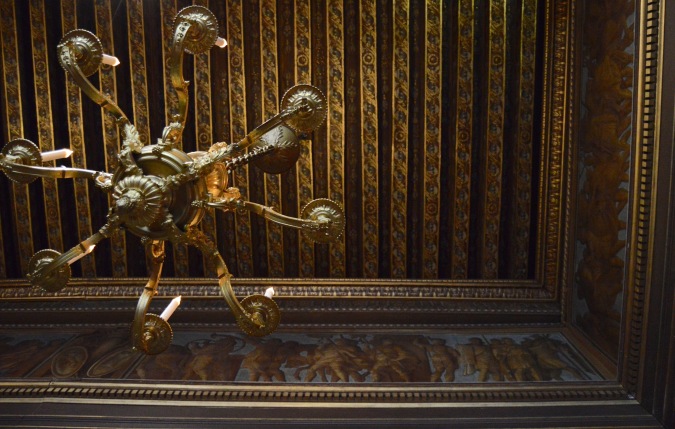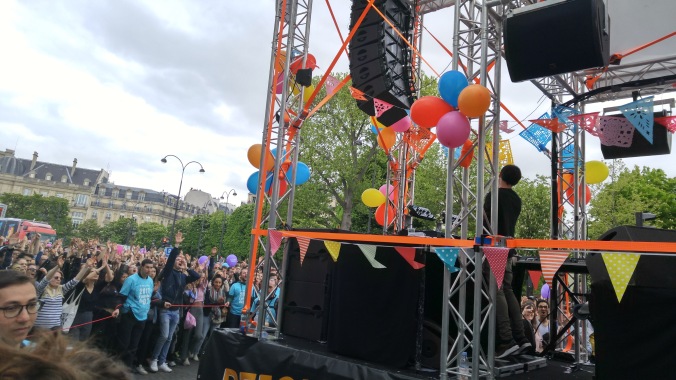Château de Vaux-le-Vicomte is a baroque French castle located in Maincy, near Melun. Inside you’ll discover silk tapestries draping the walls, hand-made furniture, decadent ceilings, marble statues and paintings by renowned artists. The castle has become a Palace for the Arts and an icon of 17th-century French architecture, design, and gardening; all with a scandalous history…

A little history:
The charming Château de Vaux-le-Vicomte was built by Nicolas Fouquet, Marquis de Belle Île and Viscount of Melun and Vaux. Later Fouquet would become the general prosecutor of the Parlement of Paris and superintendent of the finances.
The small, original estate was bought by Fouquet in 1641. The ambitious 26-year-old member of the Parlement of Paris had a cultivated personality and a love for the arts. After becoming the superintendent of finances under King Louis XIV, Fouquet began the construction of Château de Vaux-le-Vicomte in 1656.
Fouquet spared no expense during the construction of the Château de Vaux-le-Vicomte. He desired the estate to be an elaborate tribute to the arts. Fouquet enlisted the help of the greatest artists of the 17th century: architect Louis Le Vau, head gardener André Le Notre and painter-decorator Charles Le Brun. The team worked harmoniously to create a beautiful, luxurious atmosphere.

On August 17, 1661, Nicolas Fouquet hosted an extravagant soirée in honor of the Sun King, Louis XIV at his new estate, Château de Vaux-le-Vicomte. The famous inauguration of the château was organized by François Vatel and included the debut of Molière’s play “Les Fâcheux,” a grand dinner, and dazzling fireworks show.
But the party and the château were too luxurious. Though Fouquet had intended to flatter the king, Jean-Baptiste Colbert believed Fouquet’s exuberant château was built using misappropriated public funds. Therefore, Fouquet used royal funds to build his château, then presented it with flamboyance to the King he was stealing from. Trying to outshine the Sun King did not go over well with His Majesty.

Only three weeks after the party, on Sept. 5, 1661, Fouquet was arrested by d’Artagnan and Colbert organized his trial. The owner was charged with embezzlement from the monarchy’s funds to pay for the Château de Vaux-le-Vicomte. In 1664, Louis XIV overruled the judgment of the court and condemned Nicolas Fouquet to life imprisonment. Fouquet died in 1680, in the fortress of Pignerol.
The Château de Vaux-le-Vicomte was seized by the King and Fouquet’s family exiled. The King confiscated tapestries, statues and the orange trees from Vaux-le-Vicomte. He also used the same trio (Le Vau, Le Nôtre and Le Brun) for his own project- the palace and gardens of Versailles. A decade later, Madame Fouquet and her eldest son were able to recover their property.

The estate went to auction in 1875, after 30 years of abandonment, where Alfred Sommier successfully bid on the neglected château and gardens de Vaux-le-Vicomte. Sommier, a great French sugar magnate, took the effort to renovate and preserve the Château de Vaux-le-Vicomte.
Patrice de Vogüé opened the estate to the public in 1968 with the support of his wife, Christina de Vogüé. In 2015, the descendants of Alfred Sommier, brothers Ascanio, Jean-Charles and Alexandre de Vogüé become the fifth and current generation of de Vogüés to manage the estate.
FUN FACT: Château Vaux-le-Vicomte was used as a hospital during World War I
During the first World War, the French Health Service realized that their institutions wouldn’t be sufficient and called for private hospitals. Her husband having been drafted, Mrs. Sommier also responded to the call of duty. Using outbuilding of the Château Vaux-le-Vicomte, she established a well-equipped auxiliary hospital and medical team-creating the Auxiliary Hospital No. 23. The first casualties were admitted on October 7, 1914. The hospital treated a total of 1,123 casualties.
Visiting the castle:
This stunning estate is the creation of three debutant legends. France’s “Grand Siecle” (17th century), could not have culminated more exquisitely than what became the Château de Vaux-le-Vicomte. Louis Le Vau, the King’s “Principal Architect,” had already achieved acclaimed fame for his works. Le Vau drew inspiration from the ancient classics and with an Italianate theme, he developed his own style. His first grand piece, Vaux-le-Vicomte, laid the foundations for the next 150 years in French architecture.
Vaux-le-Vicomte marks a new era in garden art and redefined the French garden. André Le Nôtre, the project’s landscape architect, created the first large-scale scientific and artistic achievement for his time. The science can be seen in the use of geometric lines and tricks of perspective. The notability of the garden was realized during the lavish party on August 17, 1661. The beautiful, intriguing gardens were made to be an optical illusion. When you stroll through the garden, you discover it in stages. From the château you think you’ve seen it all, but, it is much bigger than it appears and has different levels and surprises sneakily built in. Le Nôtre became known as the landscaper of the “Grand Siècle,” and everyone who was anyone wanted him to landscape their garden. Le Nôtre is responsible for some of the greatest classical gardens in France today including Tuileries, Saint-Cloud, Chantilly and Saint-Germain-en-La
During your visit, you can pay an additional three euros to visit the dome, the highest point of the château which offers 360-degree views of the estate. I recommend you save your three bucks and just walk up to the Hercules statue. Located at the furthermost end of the garden, the Hercules statue is on an elevated hill which has a great view of the garden.
The Iron Masked Prisoner:
The story of the masked prisoner starts at the Pignerol fortress. In 1669, a new prisoner arrived with an iron masked, locked and could not be removed. This iron mask concealed his identity from the first day of his arrest until the day he died.
In complete secrecy, Nicolas Fouquet communicated only with the Governor of the fortress, Monsieur de Saint Mars, and with a valet whom the Governor attributed to the prisoner. The man in the iron mask stayed imprisoned for 34 years under the name Eustache DAUGER. His prisons successively: Pignerol, Exiles, L’ile Ste-Marguerite, and La Bastille.
Never was there another prisoner who was the subject of so much ministerial correspondence and royal instructions for Monsieur de Saint Mars, who was successively governor of the prisons of Pignerol, Exiles, Ste Marguerite, and La Bastille. The Iron Masked Prisoner’s budget was one of the most important devoted to a prisoner under the old regime. The ministerial instructions specified that the prisoner: Be treated well, does not communicate with anyone, and be killed if his face was seen.
During the old regime, certain nobles condemned to short-term sentences in prisons with frequent visitors had to wear a mask of dark tissue to preserve avoid being recognized and protect their reputation. Kings Louis XV and Louis XVI, though questioned by many, refused to disclose the identity of the Iron Masked Prisoner. Louis XVIII stated, “Je sais le mot de cette énigme: c’est l’honneur de notre aïeul Louis XIV que nous avons à garder.”
“I know the word of this enigma: it is the honor of our ancestor Louis XIV that we have to keep.”
In 1703, the prisoner died at La Bastille, with the iron mask on and his identity never revealed. Niether Voltaire, Michelet, Topin, Mercel Pagnol, Mongrédien, nor any other french historian has ever uncovered the identity of the Iron Masked Prisoner.
How to get there:
Traveling in France? If you are staying in or near Paris, Château Vaux-le-Vicomte is a perfect day trip from Paris. An inspiration for all other french castles to follow, your France vacation isn’t complete without a trip to this castle that inspired Versailles.
The Vaux-le-Vicomte website recommends that from Paris Gare de l’Est, you take the train Line P direction Provins until Verneuil l’Etang train station. From there, there is a Châteaubus shuttle which travels between this station and Château de Vaux-le-Vicomte. The shuttle is located in front of the train station exit. Caution: cash only and trains/shuttles may only be every hour.
 An alternative is the way we went. Living in Paris, we all have the Navigo Pass which can be used on the métro, buses, and trams in the city. It can also be used on trains known as RER in the entire Île-de-France. So, we took the RER D from Gare de Lyon to Meluns train station. From there we took an Über to the château. For us, it was much cheaper, quicker, and more reliant as far as departure times were concerned.
An alternative is the way we went. Living in Paris, we all have the Navigo Pass which can be used on the métro, buses, and trams in the city. It can also be used on trains known as RER in the entire Île-de-France. So, we took the RER D from Gare de Lyon to Meluns train station. From there we took an Über to the château. For us, it was much cheaper, quicker, and more reliant as far as departure times were concerned.


 joyed the atmosphere and the ambience, young and old gatheirng to see a variety of artists. The interesting idea of this parade concert was that you could either follow a stage float or stay in one place and enjoy each of the nine stages as they pass by.
joyed the atmosphere and the ambience, young and old gatheirng to see a variety of artists. The interesting idea of this parade concert was that you could either follow a stage float or stay in one place and enjoy each of the nine stages as they pass by.

